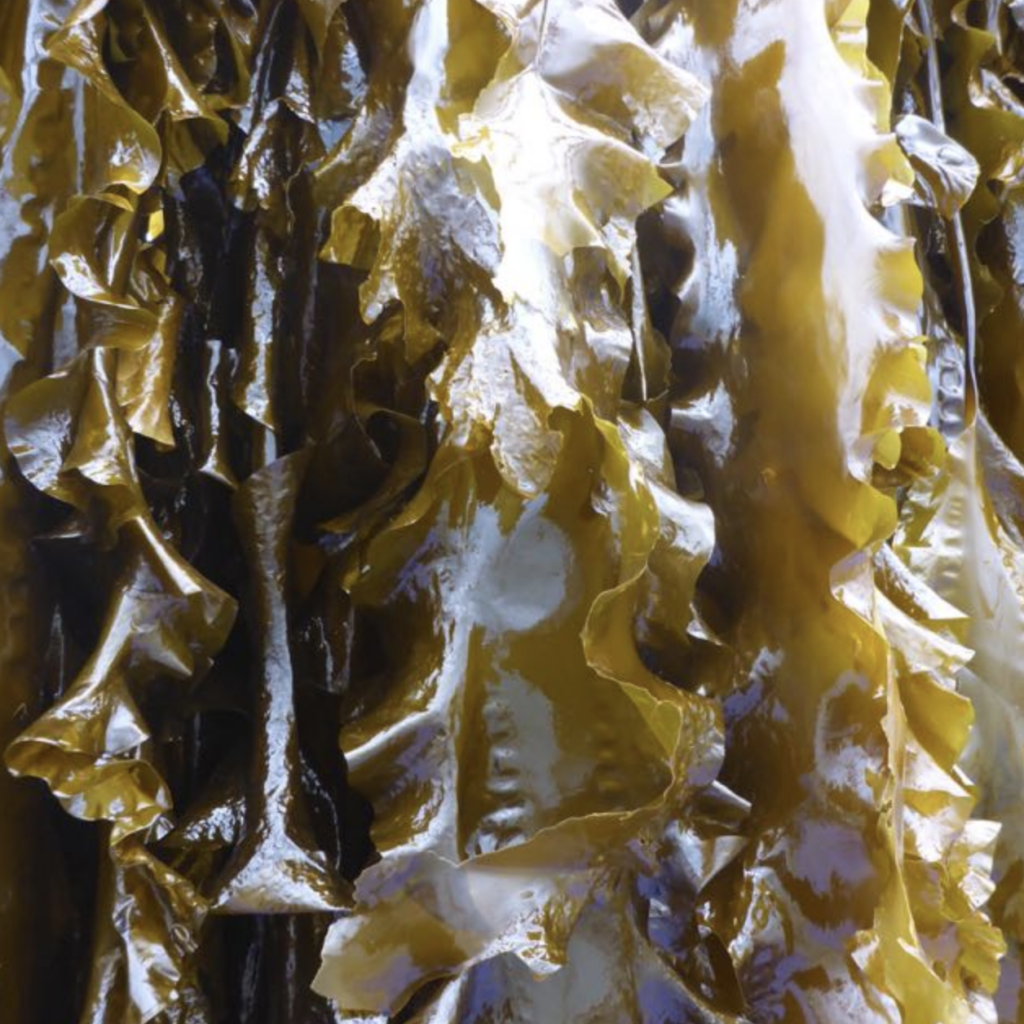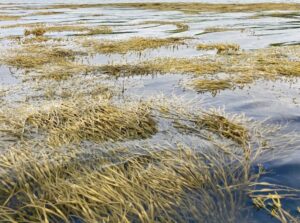Much of the wild rockweed harvesting in Hancock and Washington counties has been carried out by the Canadian company Acadian Seaplants, based in Dartmouth, Nova Scotia (https://www.acadianseaplants.com/). This company has used machine-harvesting boats to extract rockweed from several areas in the Blue Hill Peninsula, including Sedgwick, Brooklin, Deer Isle, and Brooksville. However, in April 2025, Acadian Seaplants announced that they were shutting down all of their operations in Maine due to unstable economic projections. This company was responsible for about 40% of the rockweed harvested in Maine.
Other companies include:
Maine Coast Sea Vegetables (https://seaveg.com/) in Hancock, ME
Ocean Organics (https://oceanorganics.com/seaweed/) in Waldoboro, ME
Source Micronutrients (https://www.4source.com/), processed in Brunswick, ME
North American Kelp (https://noamkelp.com/) in Waldoboro, ME
Ocean’s Balance (https://oceansbalance.com/) in Biddeford, ME (sells rockweed powder)
In some cases, these companies refer to rockweed as “kelp,” which is an informal term for brown algae. However, true kelps along the Maine coast occur in deeper water (subtidal areas). On their website, North American Kelp states: “Our harvesters gather wild rockweed, Ascophyllum nodosum, from natural beds found all along the Maine coast to make our seaweed products.” Ocean Organics also refers to rockweed as “kelp” and labels their soil amendment products as organic.
More information about commercial seaweed harvesting is available through Maine’s seaweed industry group, the Maine Seaweed Council (https://www.seaweedcouncil.org/).
What is harvested rockweed used for?
Thousands of tons of wild rockweed are harvested along the Maine coast each year with a value of about $150/ton. (Each mechanically harvested bag of rockweed is about 1 ton.) Rockweed represents about 95% of all harvested seaweed species in Maine. It is sold commercially for a wide variety of uses and products. Fresh rockweed is a packaging material for transporting lobsters and other shellfish and some fresh rockweed is sold directly to consumers as a gardening mulch/fertilizer. But by far the majority of harvested rockweed is dried within a few days in the sun or with mechanical driers, ground into a powder or granules, and used as additive for agricultural fertilizers, soil conditioners, animal feed supplements, and human nutraceuticals. Unlike dulse, for example, whole rockweed is not an edible seaweed.
of about $150/ton. (Each mechanically harvested bag of rockweed is about 1 ton.) Rockweed represents about 95% of all harvested seaweed species in Maine. It is sold commercially for a wide variety of uses and products. Fresh rockweed is a packaging material for transporting lobsters and other shellfish and some fresh rockweed is sold directly to consumers as a gardening mulch/fertilizer. But by far the majority of harvested rockweed is dried within a few days in the sun or with mechanical driers, ground into a powder or granules, and used as additive for agricultural fertilizers, soil conditioners, animal feed supplements, and human nutraceuticals. Unlike dulse, for example, whole rockweed is not an edible seaweed.
Processed rockweed that is incorporated into fertilizers has been shown to enhance stress tolerance in plants. An interesting climate-related secondary effect of rockweed (and other seaweeds) added to cattle feed is a reduction in metabolic methane production by the animals.
A company based in San Francisco, Oliver Charles, uses processed rockweed biomass from Iceland as in ingredient to make sweaters out of SeaCell fabric, claiming that it is “arguably the most sustainable material on Earth.” SeaCell is a type of Lyocell marketed in Europe.
What is an example of rockweed harvesting in our area? (Smith Cove, Brooksville, in 2021)
Around the Blue Hill Peninsula, industrial-scale commercial rockweed harvesting relies on the availability of waterfront that can accommodate cranes and trucks or large vessels to transport tons of cut rockweed to processing plants. In the summer of 2021, we observed a Canadian company, Acadian Seaplants, base their rockweed cutting activity at the Brooksville Town Landing on Smith Cove, across from Castine. We saw a machine-harvesting boat, a support boat that commuted from another town, and truck drivers who took the harvested rockweed away in an 18-wheeler semi-truck.
From June 24th– July 27th, 2021, the company parked a large telescoping lift machine overnight at the Town Landing. During this period, we estimate that more than 200 massive mesh bags of cut rockweed were harvested from Smith Cove, Holbrook Island Sanctuary, and other nearby areas. Workers used the telescoping lift to load ~30-40 bags of cut rockweed into the semi-truck on each of these dates and possibly earlier: 6/21, 6/24, 7/1, 7/6, 7/13, 7/19, and 7/27. Each bag weighs ~1 ton.

Harvesting occurred close to shore where it was easy to observe the process. At lush rockweed beds in sheltered coves and ledges, the machine-harvester boat cut off all but ~16 inches above the rockweed holdfast, as required by the Department of Marine Resource (see regulations here). Prior to cutting, many of these areas had extensive floating mats of rockweed averaging ~3-5 ft in height. After cutting, the affected floating mats had been removed. We estimate that at least 8 years would be needed for a 4-ft tall rockweed individual to recover its former height. This is based on typical growth rates of ~3-4 inches per year starting from a cut height of 16 inches.
When each mesh bag was filled with shredded rockweed via the machine-harvester boat’s vacuum pump, it was tied to a nearby float. Then, with the aid of the support boat, the bags were moved to a central mooring zone in one area of the Cove. When each group of 30-40 mesh bags was ready, the bags were towed over to intertidal mudflats on private property next to the Town Landing, where they were made secure by tying ropes onto the upland area. The 18-wheeler semi-truck usually arrived that evening or the next day to take the harvested rockweed away after the contents of each bag were emptied into the truck’s open cargo area.
Local property owners felt that the industrial scale of this operation was too large for the Town Landing, which has only 11 parking spaces and 0.6 acres of public land. A letter signed by twenty neighbors was presented to the Brooksville Town Selectmen and the Town Harbor Committee in mid-August to inform them about the situation. The Town Landing is zoned for “limited residential/commercial use.” Currently, this area is used extensively for boating, recreational fishing, and swimming throughout the summer, while its use by clammers has decreased sharply in recent years. The small picnic area also serves as a venue for social gatherings, weddings, and memorial services.
Which other Maine seaweeds have commercial value and how are they harvested?
Of the hundreds of different seaweeds found along the Maine coast there are only about ten that are commercially harvested. More than 95% (by weight) of the harvested seaweed in Maine is wild harvested rockweed (Ascophyllum nodosum). The remaining seaweeds are harvested from nature or increasingly grown by aquaculture. They are:

Kelps – mostly grown with aquaculture
- Saccharina latissima (sugar kelp)
- Saccharina latissima f. angustissima (skinny kelp)
- Laminaria digitata (horsetail kelp)
- Alaria esculenta (winged kelp)
Palmaria palmata (dulse)
Chondrus crispus (Irish moss)
Porphyra species (nori)
Ulva lactuca (sea lettuce)
Fucus vesiculosus (bladderwrack)
Ascophyllum nodosum f. scorpioides (wormweed)
The four kelps are annual or short-lived perennial seaweeds that are most suited to aquaculture. They are grown from sporelings raised in nurseries and set out on suspended lines in October and grown for seven months. They grow 2-3 cm/day and reach a length of 2-3 meters when harvested. Kelps are used fresh or after drying in various human foods (salads, teas, snack bars, pastas, beverages, spice blends or as whole leaf, flakes, or powders).
The next four species of seaweeds – dulse, Irish moss, nori, and sea lettuce – are harvested from nature, typically by hand. There are some seaweed harvesters who also gather wild kelps for the fresh market. Bladderwrack is typically dried for nutritional supplements and skin care products. Although there are no regulations on wild harvested seaweed (other than rockweed), guidelines from the Maine Seaweed Council recommend leaving the holdfast intact and harvesting no more than 30% per year.
Most of the seaweed aquaculture farmers and wild seaweed harvesters are small scale operations, restricted to a limited geography and conscious of maintaining sustainability of the seaweeds. This is feasible because the seaweeds are primarily annuals or short-lived perennials. In contrast, rockweed is slow-growing and long-lived, requiring several years to grow back after each harvest.
Wormweed is a curious exception and is related to rockweed. It grows unattached, tangled in the upright stalks of salt marsh grasses. It is harvested by hand and used as packaging for worms used as bait in sport fishing.
A few resources:
Aquaculture in Shared Waters (features kelp farming; Island Institute, 2015)
How is rockweed harvesting regulated in our area?
Rockweed harvesting is regulated by the Maine Department of Marine Resources (DMR), which stipulates requirements for obtaining a harvester license, reporting the amount harvested each year, and paying buyer’s a surcharge if more then 10 wet tons are harvested annually. The amount harvested each year is reported by sectors (see the DMR sector map).
The DMR requires that “a minimum of 16 inches of the rockweed shall remain above the holdfast”, which should have the effect that “the lowest lateral branches shall remain undisturbed and attached to the main stalk of the rockweed that is attached to the substrate.”
The DMR has no restrictions on how much rockweed is harvested or how often it is harvested from the same location (except in the Cobscook Bay Management Area).
Rockweed cannot be harvested from national parks, national wildlife refuges, or Maine State Parks (such as Holbrook Island Sanctuary in Brooksville).
In 2019, the Maine Supreme Court ruled that harvesting rockweed on private property requires permission of the upland property owner (see Legal).

Reference –
https://www.maine.gov/dmr/fisheries/commercial/fisheries-by-species/rockweed















